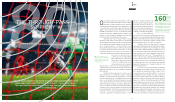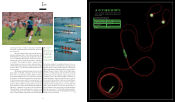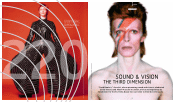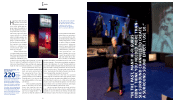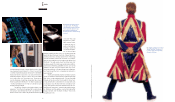Sennheiser 2012 Annual Report Download - page 17
Download and view the complete annual report
Please find page 17 of the 2012 Sennheiser annual report below. You can navigate through the pages in the report by either clicking on the pages listed below, or by using the keyword search tool below to find specific information within the annual report.
32
RUBRIK
440 Hz
using the Pythagorean method, in which the frequency re-
lationship between all intervals is based on the perfect fifth.
With its emphasis on mathematical purity, tuning was set at
C = 256 (A432), a binary system in which C remains a whole
number all the way down to 1 Hz. The lower tuning marked
the rise of the singer as composers such as Wolfgang Ama-
deus Mozart and Ludwig van Beethoven were able to better
leverage the colors and nuances of the different natural vo-
cal registers.
However, as classicism gave way to Romanticism,
pitch inflation took a turn for the worse. During the Con-
gress of Vienna in 1815, Czar Alexander I set off a pitch in-
flation alarm by calling for a brighter sound. Possibly as a
means to placate a man with some 450,000 troops located
near disputed territories and who claimed “I shall be King of
Poland, King of Prussia and King of Saxony,” the crowned
heads of Europe were immediately on board. While classical
musicians resisted, the new Romantic school led by Friedrich
Liszt and his son-in-law Richard Wagner began to drive pitch
inflation until, by 1850, pitches among the major European
theaters ranged from A420 to A460.
The issue seems to have become so heated among
singers that a committee of composers championed by Gia-
como Rossini called for the first standardization of pitch in
modern times. Passed by the French government on Febru-
ary 16, 1859, the diaposan normal was set at A435. Within
20 years, however, pitch inflation had skyrocketed back up
to A460, leading Giuseppe Verdi to complain that “what we
call an A in Rome is a B-flat in Paris.” In an effort to address
rampant pitch inflation, the Italian Parliament passed a bill
to return to its classical roots of C = 256. Though Verdi’s tun-
ing never became an international standard, pitch remained
relatively constant (A432–435) until World War II.
Classical music of the 20th century mirrors an era
marked by immense change. The balance of world power
had shifted, and the sudden emergence and rapid pace of
technology that took humans off the horse and to the moon
brought words like “holocaust” and “nuclear war” into com-
mon usage. Life became an experiment and so did music, as
composers broke away from traditional
tonality to create new innovations in mu-
sical forms and styles. Possibly in reaction
to a world gone mad, efforts made in
1939, 1953 and as recently as 1971 to
standardize concert pitch to A440 have
been so compelling that many believe it to
be the international standard it is not.
The jet age has put particular de-
mands on the singer. No longer traveling
by ship between the United States, Europe
and South America accompanied by their
own pianists and with their own costumes
packed away in steamer trucks, these vo-
cal nomads fly around the world, singing
in Berlin one day and New York the next. A
full stage rehearsal may mean nothing
more than arriving at the theater before
the performance and being walked
through their paces. And whereas Ro-
dolfo’s high C in “La Bohème” may have
been tuned at A440 in Chicago, at A444
and above, the same high C would be even
higher in Germany, causing some opera
houses to transpose the aria down by a
half-step.
As dramatic as innovations in mu-
sical form and styles were in 20th-century music, so was
the rapid change in recording technology. What began as a
mechanical device that used a horn to capture the now-fa-
mous words “Mary had a little lamb” was thrust forward by
electricity and digitalization to create state-of-the-art
technologies that have given sound engineers new digital
tools to help dispel the specter of pitch hyper-inflation and
possibly even resolve the pitch debate. For instance, the
new Sennheiser MKH 8090, a wide cardioid condenser mi-
crophone with a sound that seems to “shine,” giving an
orchestra the brilliance it demands at a pitch the singer
longs for.
“WITH THE THE RIGHT MICRO-
PHONE, THE SPECTER OF PITCH
INFLATION CAN BE DISPELLED.”
j MKH 8090
The high-quality microphone with a wide cardioid
pick-up pattern is analog- and digital-compatible. It
is particularly suitable for orchestral recordings.
Sennheiser MKH 8090 studio condenser microphone
Frequency response 10–60,000 Hz
Pick-up pattern wide-cardioid
Nominal impedance 25 ohms
Weight 25 g


